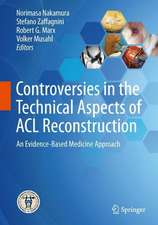Late Reconstructions of Injured Ligaments of the Knee
Editat de K. P. Schulitz Contribuţii de M.E. Blazina, D.H. O'Donoghue Editat de H. Krahl, W. H. Stein Contribuţii de S.L. James, J.C. Kennedy, A. Trillaten Limba Engleză Paperback – 18 apr 2012
Preț: 708.06 lei
Preț vechi: 745.32 lei
-5% Nou
Puncte Express: 1062
Preț estimativ în valută:
135.49€ • 144.88$ • 112.97£
135.49€ • 144.88$ • 112.97£
Carte tipărită la comandă
Livrare economică 17 aprilie-01 mai
Preluare comenzi: 021 569.72.76
Specificații
ISBN-13: 9783642872761
ISBN-10: 364287276X
Pagini: 136
Ilustrații: VIII, 122 p.
Dimensiuni: 170 x 244 x 7 mm
Greutate: 0.23 kg
Ediția:Softcover reprint of the original 1st ed. 1978
Editura: Springer Berlin, Heidelberg
Colecția Springer
Locul publicării:Berlin, Heidelberg, Germany
ISBN-10: 364287276X
Pagini: 136
Ilustrații: VIII, 122 p.
Dimensiuni: 170 x 244 x 7 mm
Greutate: 0.23 kg
Ediția:Softcover reprint of the original 1st ed. 1978
Editura: Springer Berlin, Heidelberg
Colecția Springer
Locul publicării:Berlin, Heidelberg, Germany
Public țintă
ResearchDescriere
Different views about the biomechanics of the knee joint and late re construction of ligamentous injuries underline the obstacles impeding the establishment of generally acceptable principles for the treat ment of such lesions. As late as June 1976, HUGHSTON emphasized in the Journal of Bone and Joint Surgery that in spite of excellent anatomic studies, substantial uncertainty still prevails in knee joint surgery. Even the signifi cance of the anterior drawer sign for ruptures of the anterior cru ciate ligament is interpreted quite diversely, as illustrated in a comparison of HUGHSTON, GIRGIS, TORG, and SCHIECK, who give varying opinions concerning the indication related to the age of the patient or possible earlier joint damage as well as concerning the prognosis for untreated knee joints. The question still remains as to how often an intra-articular ligamentous replacement should be carried out in addition to extra-articular techniques (0 'DONOGHUE, SLOCUM, NICHOLAS, HUGHSTON). Lastly the question of synthetic ligament replacement must be clarified. After basic research has well advanced, clinical ex perience must be discussed. Statements concerning the therapeutic value of diverse procedures based solely on knowledge of the literature remain problematic. For this reason a workshop was held at the University of Heidelberg in the Orthopedic Clinic (Head: Prof. Dr. H. COTTA) in June 1977, with the aim of bringing together representatives of the different leading schools in a round table discussion to comment on still unsolved ques tions.
Cuprins
1. Surgical Anatomy of the Knee. With 6 Figures.- Medial Side of the Knee.- Posterior Structures of the Knee.- Lateral Structures.- Cruciate Ligaments.- Menisci.- Suggested Reading.- Discussion.- 2. Biomechanics of the Ligaments of the Knee.- Method of Measurement.- Laboratory Testing and Results.- Importance of Tests for Clinical Practice.- 3. Biomechanic Discussion of the Polyflex Ligament With 2 Figures.- Properties of Richards Polyflex Ligament.- Results of Laboratory Testing.- Clinical Experience and Suggestions for Improvement.- Discussion.- 4. Classification of Knee Joint Instability Resulting From Ligamentous Damage.- Classification.- Discussion.- Description of Classification.- A. One-Plane Instabilities.- B. Rotatory Instabilities.- C. Combined Instabilities.- Discussion.- 5. Diagnosis of Different Instabilities. With 11 Figures.- Goals of Treatment.- Clinical Picture.- Clinical Aspects of Knee Anatomy.- Location of Injury.- Method of Examination.- References.- 6. Assessment of Chronic Ligamentous Instability Using Arthrography, Arthroscopy, and Anesthesia. With 1 Figure.- Diagnosis Using Normal Clinical Methods.- Diagnostic Use of Arthrography.- Diagnostic Use of Arthroscopy.- Examination Under Anesthesia.- Discussion.- 7. Procedures Utilized for Chronic Ligamentous Instability of the Knee, Including a Statistical Review With 4 Figures.- Statistical Review.- Description of Some Procedures.- 8. Reconstruction for Medial Instability of the Knee. Surgical Technique. With 8 Figures.- Advisability of Knee Reconstruction.- Surgical Technique.- Results.- Complications.- Conclusion.- References.- 9. Reconstruction of Chronic Medial Ligament Instability. With 5 Figures.- Diagnosis of Instability.- Reconstruction Method.- Suggested Reading.- Discussion.- 10. Anterior Subluxation of the Lateral Tibial Plateau.- Surgical Technique.- Common Surgical Errors.- Results of Surgical Treatment 9.- 11. Posterolateral Instability. With 4 Figures.- Clinical Aspects and Examination Methods.- Surgical Treatment.- Results.- Discussion.- 12. Isolated Tear of the Anterior Cruciate Ligament.- Criteria for Possible Diagnosis.- Possible Treatment.- 13. Prosthetic Ligaments-Indications.- Discussion.
















